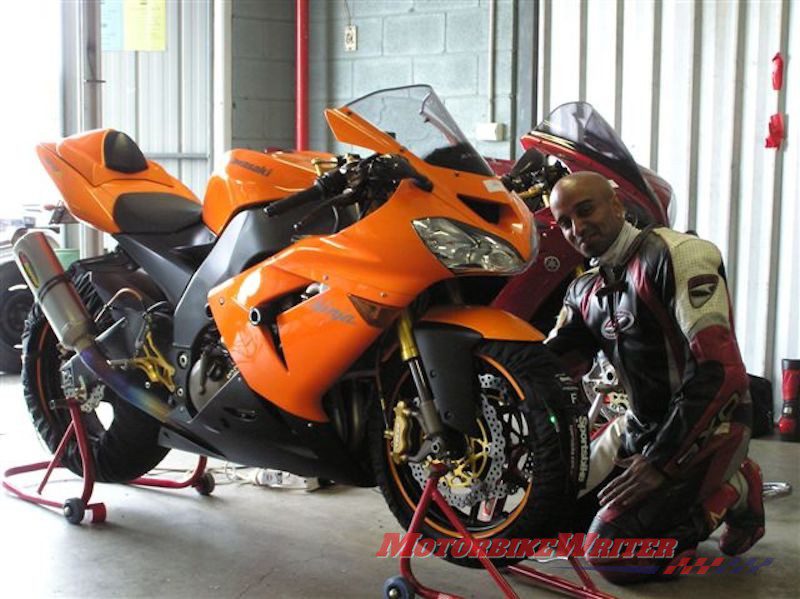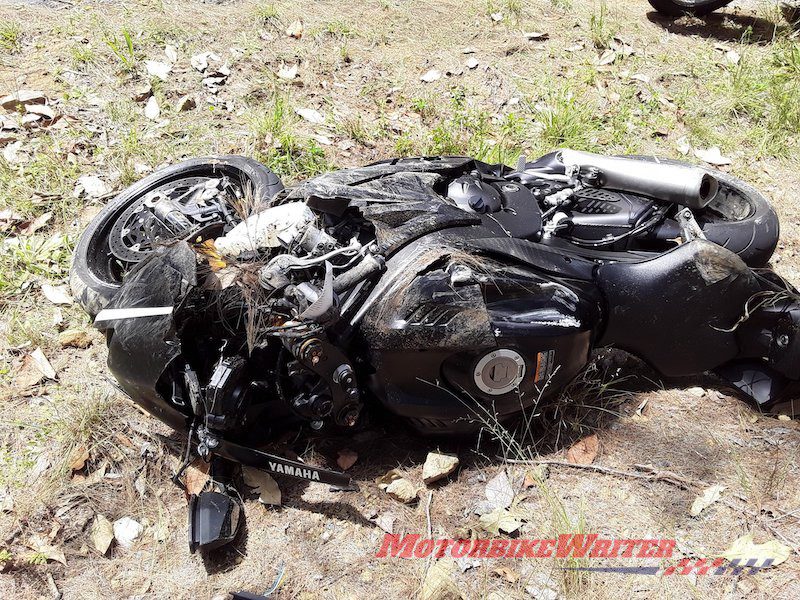Unlike drivers, any accident involving a rider and pillion is likely to have more serious consequences and a greater likelihood of a criminal charge as injury and death is more likely.
So says NSW traffic and criminal law specialist Chris Kalpage who has previously written these articles for us: tips on what to do when pulled over by police; defences to speeding fines based on a police officer’s estimate and defences to a Lidar speeding fine.
Now the motorcycling enthusiast solicitor advises on the serious consequences of being involved in a motorcycle crash:

Serious consequences
Most people who have an accident where they are at fault face the consequences of, at least, a charge of negligent driving. Unfortunately unlike a minor car accident where driver and passenger are uninjured an accident on a motorcycle is more than likely to result in injury. If your pillion is injured you are at considerable risk of being charged.
I have acted for clients who have had accidents where their pillions have had deep cuts, broken bones and even died and the rider has been charged. Although, after a protracted court case, they have been acquitted.
In the case of death or serious injury, there are the serious consequences of facing jail time if convicted. Generally, if there is a death and a question of fault, the police are likely to charge and leave it to the courts to determine guilt or innocence.
Scientific evidence
The difficulty in these cases and the expense is the need for scientific evidence especially if there are no witnesses.
In one case, a rider and pillion were riding out by the northern beaches late one evening. A taxi driver who was travelling in the opposite direction said he didn’t see the bike — not that he was particularly paying attention — but heard it. As it had a noisy aftermarket exhaust he presumed it must have been going fast.
He saw sparks in his rear vision mirror as the bike hit the embankment. The pillion was high-sided into a tree. The rider’s body was smashed from top to bottom and how he survived the months of coma, hospitalisation and years of surgery and rehabilitation was a testament to his strength of character and determination.
Sadly his pillion died at the scene, the cause of the accident was uncertain but as a person had died he was charged. If convicted he would be incarcerated.
Not only was he recovering from catastrophic injuries and the fact that his friend had died, he now had all the stress of a court case that could take at least a year to complete.
No one had seen the accident, the rider who had a head injury had no recollection of the event at all.
The DPP who had pressure from the family and deep pockets as a government institution kept putting forward expert reports and theories which had to be countered.
Let alone witness statements from people who had seen a bike doing a wheelie 10km from the crash site. On a road that attracts a lot of riders, no one could identify the rider charged as the bike in question.
I got to the scene within hours of the accident and managed to have photos of the scene and debris left from the bike taken.
Spurious arguments
Various spurious arguments were raised by the prosecution:
- Because the radius of the curve was such that a bike could go around the curve at significantly greater than the speed limit the rider must have been traveling faster than the hypothetical speed. Our experts assessed the maximum potential speed that the corner could be taken at as much less. Further, the accident occurred before the corner. They also hypothesised that a mark on the road was a yaw mark and therefore the bike was travelling at a certain speed. It was again positively debunked by our expert. Eventually the best the prosecution could estimate was maybe 1km/h over the speed limit.
- The police in attendance stood up what was left of the bike and clicked down through the gears then saying that it was in fourth gear and because the analogue tachometer was at 7000rpm it was traveling at a certain speed. This did not take into account that he had a reverse pattern gearshift and that analogue instruments can jump on impact and freeze.
- The remains of the bike were held by police at the station. I attended with an expert who did a forensic examination of the clutch cable that showed the likelihood that on pulling in the clutch and changing gear it snapped and momentarily locked the rear wheel, causing a loss of control. Since the pillion sits higher than the rider with limited hold, she was high-sided into the tree. Therefore, the accident may have been caused by sudden mechanical failure and not the manner of riding.
- The prosecution tried to argue that the bike had travelled off the road and up an embankment where the pillion was found because there was a black mark on a tree and the bike was black. As I had examined the area within hours and examined the embankment it was clear that the black mark on the tree was from a bush fire having charred the tree. Secondly, they relied on debris that appeared to be at the top of the embankment, which we established, did not belong to the bike.
However every time we debunked the DPP’s theories, they would get a new expert costing more money.
We then ran a committal proceeding in the local court for a number of days to attempt to avoid going to the District Court. The Magistrate in the local court threw out the prosecution case, making scathing remarks against the prosecution and awarding costs.
Conclusions
Early and careful investigation is vital, while jumping to simplistic assumptions is dangerous. If you wait until you are charged, which can be months later, the crash scene may have changed. The road may have changed, surrounding shrubbery that may have obstructed your view may no longer be there, nor those mysterious black marks on trees.
Secondly just because you lose control of your bike does not necessarily mean that you were riding in a dangerous or negligent manner, even if you are riding over the speed limit.
Finally don’t think it can’t happen to you no matter how careful you are. I have had to defend too many people who hopped on their bike that morning never for one moment thinking it would happen to them.
Disclaimer
This article is for reader information and interest only and is based on New South Wales law. It is not intended to be comprehensive, and does not constitute and must not be relied on as legal advice.
Please be aware that every case is different and the matters raised may not be of specific relevance to your situation but may have a general application. You must seek specific advice tailored to your circumstances. Chris is happy to talk to anyone needing clarification. He can be contacted on 0418 211074.


